Yuhan Li
GraphRAG-R1: Graph Retrieval-Augmented Generation with Process-Constrained Reinforcement Learning
Jul 31, 2025Abstract:Graph Retrieval-Augmented Generation (GraphRAG) has shown great effectiveness in enhancing the reasoning abilities of LLMs by leveraging graph structures for knowledge representation and modeling complex real-world relationships. However, existing GraphRAG methods still face significant bottlenecks when handling complex problems that require multi-hop reasoning, as their query and retrieval phases are largely based on pre-defined heuristics and do not fully utilize the reasoning potentials of LLMs. To address this problem, we propose GraphRAG-R1, an adaptive GraphRAG framework by training LLMs with process-constrained outcome-based reinforcement learning (RL) to enhance the multi-hop reasoning ability. Our method can decompose complex problems, autonomously invoke retrieval tools to acquire necessary information, and perform effective reasoning. Specifically, we utilize a modified version of Group Relative Policy Optimization (GRPO) that supports rollout-with-thinking capability. Next, we design two process-constrained reward functions. To handle the shallow retrieval problem, we design a Progressive Retrieval Attenuation (PRA) reward to encourage essential retrievals. Then, to handle the over-thinking problem, we design Cost-Aware F1 (CAF) reward to balance the model performance with computational costs. We further design a phase-dependent training strategy, containing three training stages corresponding to cold start and these two rewards. Lastly, our method adopts a hybrid graph-textual retrieval to improve the reasoning capacity. Extensive experimental results demonstrate that GraphRAG-R1 boosts LLM capabilities in solving complex reasoning problems compared to state-of-the-art GraphRAG methods on both in-domain and out-of-domain datasets. Furthermore, our framework can be flexibly integrated with various existing retrieval methods, consistently delivering performance improvements.
ACM-UNet: Adaptive Integration of CNNs and Mamba for Efficient Medical Image Segmentation
May 30, 2025Abstract:The U-shaped encoder-decoder architecture with skip connections has become a prevailing paradigm in medical image segmentation due to its simplicity and effectiveness. While many recent works aim to improve this framework by designing more powerful encoders and decoders, employing advanced convolutional neural networks (CNNs) for local feature extraction, Transformers or state space models (SSMs) such as Mamba for global context modeling, or hybrid combinations of both, these methods often struggle to fully utilize pretrained vision backbones (e.g., ResNet, ViT, VMamba) due to structural mismatches. To bridge this gap, we introduce ACM-UNet, a general-purpose segmentation framework that retains a simple UNet-like design while effectively incorporating pretrained CNNs and Mamba models through a lightweight adapter mechanism. This adapter resolves architectural incompatibilities and enables the model to harness the complementary strengths of CNNs and SSMs-namely, fine-grained local detail extraction and long-range dependency modeling. Additionally, we propose a hierarchical multi-scale wavelet transform module in the decoder to enhance feature fusion and reconstruction fidelity. Extensive experiments on the Synapse and ACDC benchmarks demonstrate that ACM-UNet achieves state-of-the-art performance while remaining computationally efficient. Notably, it reaches 85.12% Dice Score and 13.89mm HD95 on the Synapse dataset with 17.93G FLOPs, showcasing its effectiveness and scalability. Code is available at: https://github.com/zyklcode/ACM-UNet.
Can LLMs Alleviate Catastrophic Forgetting in Graph Continual Learning? A Systematic Study
May 24, 2025Abstract:Nowadays, real-world data, including graph-structure data, often arrives in a streaming manner, which means that learning systems need to continuously acquire new knowledge without forgetting previously learned information. Although substantial existing works attempt to address catastrophic forgetting in graph machine learning, they are all based on training from scratch with streaming data. With the rise of pretrained models, an increasing number of studies have leveraged their strong generalization ability for continual learning. Therefore, in this work, we attempt to answer whether large language models (LLMs) can mitigate catastrophic forgetting in Graph Continual Learning (GCL). We first point out that current experimental setups for GCL have significant flaws, as the evaluation stage may lead to task ID leakage. Then, we evaluate the performance of LLMs in more realistic scenarios and find that even minor modifications can lead to outstanding results. Finally, based on extensive experiments, we propose a simple-yet-effective method, Simple Graph Continual Learning (SimGCL), that surpasses the previous state-of-the-art GNN-based baseline by around 20% under the rehearsal-free constraint. To facilitate reproducibility, we have developed an easy-to-use benchmark LLM4GCL for training and evaluating existing GCL methods. The code is available at: https://github.com/ZhixunLEE/LLM4GCL.
Reinforcement Learning with Continuous Actions Under Unmeasured Confounding
May 01, 2025Abstract:This paper addresses the challenge of offline policy learning in reinforcement learning with continuous action spaces when unmeasured confounders are present. While most existing research focuses on policy evaluation within partially observable Markov decision processes (POMDPs) and assumes discrete action spaces, we advance this field by establishing a novel identification result to enable the nonparametric estimation of policy value for a given target policy under an infinite-horizon framework. Leveraging this identification, we develop a minimax estimator and introduce a policy-gradient-based algorithm to identify the in-class optimal policy that maximizes the estimated policy value. Furthermore, we provide theoretical results regarding the consistency, finite-sample error bound, and regret bound of the resulting optimal policy. Extensive simulations and a real-world application using the German Family Panel data demonstrate the effectiveness of our proposed methodology.
StyleLoco: Generative Adversarial Distillation for Natural Humanoid Robot Locomotion
Mar 19, 2025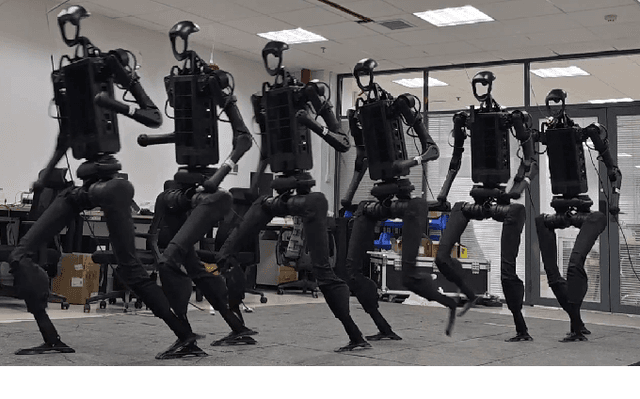
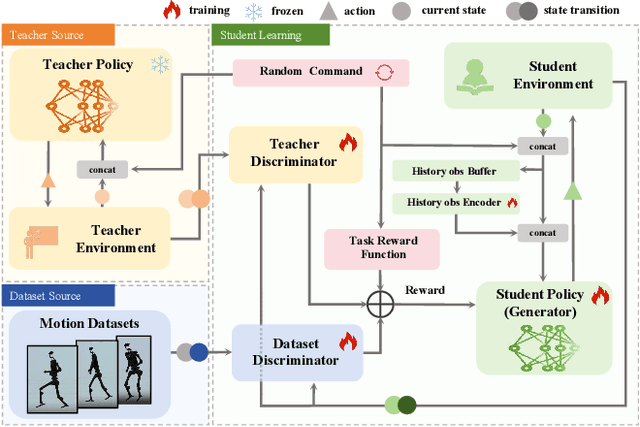
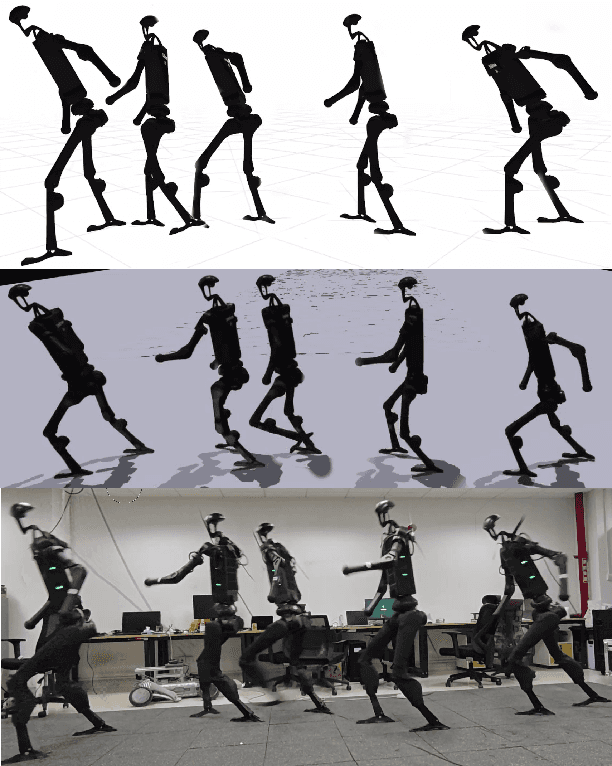
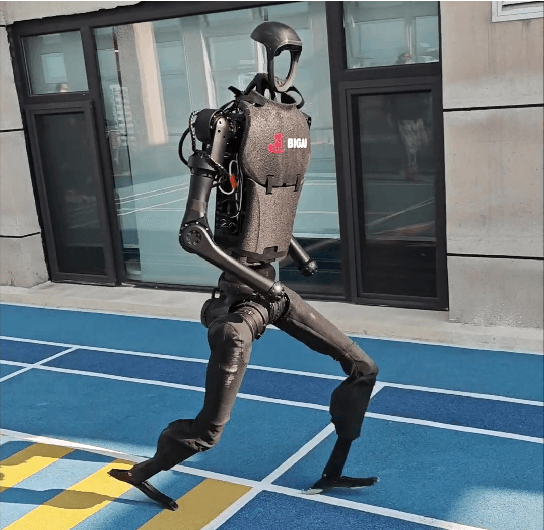
Abstract:Humanoid robots are anticipated to acquire a wide range of locomotion capabilities while ensuring natural movement across varying speeds and terrains. Existing methods encounter a fundamental dilemma in learning humanoid locomotion: reinforcement learning with handcrafted rewards can achieve agile locomotion but produces unnatural gaits, while Generative Adversarial Imitation Learning (GAIL) with motion capture data yields natural movements but suffers from unstable training processes and restricted agility. Integrating these approaches proves challenging due to the inherent heterogeneity between expert policies and human motion datasets. To address this, we introduce StyleLoco, a novel two-stage framework that bridges this gap through a Generative Adversarial Distillation (GAD) process. Our framework begins by training a teacher policy using reinforcement learning to achieve agile and dynamic locomotion. It then employs a multi-discriminator architecture, where distinct discriminators concurrently extract skills from both the teacher policy and motion capture data. This approach effectively combines the agility of reinforcement learning with the natural fluidity of human-like movements while mitigating the instability issues commonly associated with adversarial training. Through extensive simulation and real-world experiments, we demonstrate that StyleLoco enables humanoid robots to perform diverse locomotion tasks with the precision of expertly trained policies and the natural aesthetics of human motion, successfully transferring styles across different movement types while maintaining stable locomotion across a broad spectrum of command inputs.
Towards Fast, Memory-based and Data-Efficient Vision-Language Policy
Mar 13, 2025



Abstract:Vision Language Models (VLMs) pretrained on Internet-scale vision-language data have demonstrated the potential to transfer their knowledge to robotic learning. However, the existing paradigm encounters three critical challenges: (1) expensive inference cost resulting from large-scale model parameters, (2) frequent domain shifts caused by mismatched data modalities, and (3) limited capacity to handle past or future experiences. In this work, we propose LiteVLP, a lightweight, memory-based, and general-purpose vision-language policy generation model. LiteVLP is built upon a pre-trained 1B-parameter VLM and fine-tuned on a tiny-scale and conversation-style robotic dataset. Through extensive experiments, we demonstrate that LiteVLP outperforms state-of-the-art vision-language policy on VIMA-Bench, with minimal training time. Furthermore, LiteVLP exhibits superior inference speed while maintaining exceptional high accuracy. In long-horizon manipulation tasks, LiteVLP also shows remarkable memory ability, outperforming the best-performing baseline model by 18.8%. These results highlight LiteVLP as a promising model to integrating the intelligence of VLMs into robotic learning.
G-Refer: Graph Retrieval-Augmented Large Language Model for Explainable Recommendation
Feb 18, 2025Abstract:Explainable recommendation has demonstrated significant advantages in informing users about the logic behind recommendations, thereby increasing system transparency, effectiveness, and trustworthiness. To provide personalized and interpretable explanations, existing works often combine the generation capabilities of large language models (LLMs) with collaborative filtering (CF) information. CF information extracted from the user-item interaction graph captures the user behaviors and preferences, which is crucial for providing informative explanations. However, due to the complexity of graph structure, effectively extracting the CF information from graphs still remains a challenge. Moreover, existing methods often struggle with the integration of extracted CF information with LLMs due to its implicit representation and the modality gap between graph structures and natural language explanations. To address these challenges, we propose G-Refer, a framework using graph retrieval-augmented large language models (LLMs) for explainable recommendation. Specifically, we first employ a hybrid graph retrieval mechanism to retrieve explicit CF signals from both structural and semantic perspectives. The retrieved CF information is explicitly formulated as human-understandable text by the proposed graph translation and accounts for the explanations generated by LLMs. To bridge the modality gap, we introduce knowledge pruning and retrieval-augmented fine-tuning to enhance the ability of LLMs to process and utilize the retrieved CF information to generate explanations. Extensive experiments show that G-Refer achieves superior performance compared with existing methods in both explainability and stability. Codes and data are available at https://github.com/Yuhan1i/G-Refer.
RAGDiffusion: Faithful Cloth Generation via External Knowledge Assimilation
Nov 29, 2024



Abstract:Standard clothing asset generation involves creating forward-facing flat-lay garment images displayed on a clear background by extracting clothing information from diverse real-world contexts, which presents significant challenges due to highly standardized sampling distributions and precise structural requirements in the generated images. Existing models have limited spatial perception and often exhibit structural hallucinations in this high-specification generative task. To address this issue, we propose a novel Retrieval-Augmented Generation (RAG) framework, termed RAGDiffusion, to enhance structure determinacy and mitigate hallucinations by assimilating external knowledge from LLM and databases. RAGDiffusion consists of two core processes: (1) Retrieval-based structure aggregation, which employs contrastive learning and a Structure Locally Linear Embedding (SLLE) to derive global structure and spatial landmarks, providing both soft and hard guidance to counteract structural ambiguities; and (2) Omni-level faithful garment generation, which introduces a three-level alignment that ensures fidelity in structural, pattern, and decoding components within the diffusing. Extensive experiments on challenging real-world datasets demonstrate that RAGDiffusion synthesizes structurally and detail-faithful clothing assets with significant performance improvements, representing a pioneering effort in high-specification faithful generation with RAG to confront intrinsic hallucinations and enhance fidelity.
GCoder: Improving Large Language Model for Generalized Graph Problem Solving
Oct 24, 2024
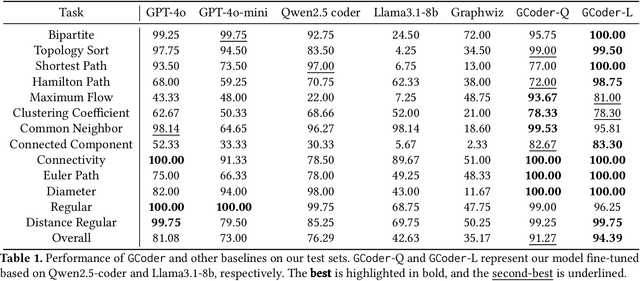


Abstract:Large Language Models (LLMs) have demonstrated strong reasoning abilities, making them suitable for complex tasks such as graph computation. Traditional reasoning steps paradigm for graph problems is hindered by unverifiable steps, limited long-term reasoning, and poor generalization to graph variations. To overcome these limitations, we introduce GCoder, a code-based LLM designed to enhance problem-solving in generalized graph computation problems. Our method involves constructing an extensive training dataset, GraphWild, featuring diverse graph formats and algorithms. We employ a multi-stage training process, including Supervised Fine-Tuning (SFT) and Reinforcement Learning from Compiler Feedback (RLCF), to refine model capabilities. For unseen tasks, a hybrid retrieval technique is used to augment performance. Experiments demonstrate that GCoder outperforms GPT-4o, with an average accuracy improvement of 16.42% across various graph computational problems. Furthermore, GCoder efficiently manages large-scale graphs with millions of nodes and diverse input formats, overcoming the limitations of previous models focused on the reasoning steps paradigm. This advancement paves the way for more intuitive and effective graph problem-solving using LLMs. Code and data are available at here: https://github.com/Bklight999/WWW25-GCoder/tree/master.
GLBench: A Comprehensive Benchmark for Graph with Large Language Models
Jul 11, 2024



Abstract:The emergence of large language models (LLMs) has revolutionized the way we interact with graphs, leading to a new paradigm called GraphLLM. Despite the rapid development of GraphLLM methods in recent years, the progress and understanding of this field remain unclear due to the lack of a benchmark with consistent experimental protocols. To bridge this gap, we introduce GLBench, the first comprehensive benchmark for evaluating GraphLLM methods in both supervised and zero-shot scenarios. GLBench provides a fair and thorough evaluation of different categories of GraphLLM methods, along with traditional baselines such as graph neural networks. Through extensive experiments on a collection of real-world datasets with consistent data processing and splitting strategies, we have uncovered several key findings. Firstly, GraphLLM methods outperform traditional baselines in supervised settings, with LLM-as-enhancers showing the most robust performance. However, using LLMs as predictors is less effective and often leads to uncontrollable output issues. We also notice that no clear scaling laws exist for current GraphLLM methods. In addition, both structures and semantics are crucial for effective zero-shot transfer, and our proposed simple baseline can even outperform several models tailored for zero-shot scenarios. The data and code of the benchmark can be found at https://github.com/NineAbyss/GLBench.
 Add to Chrome
Add to Chrome Add to Firefox
Add to Firefox Add to Edge
Add to Edge